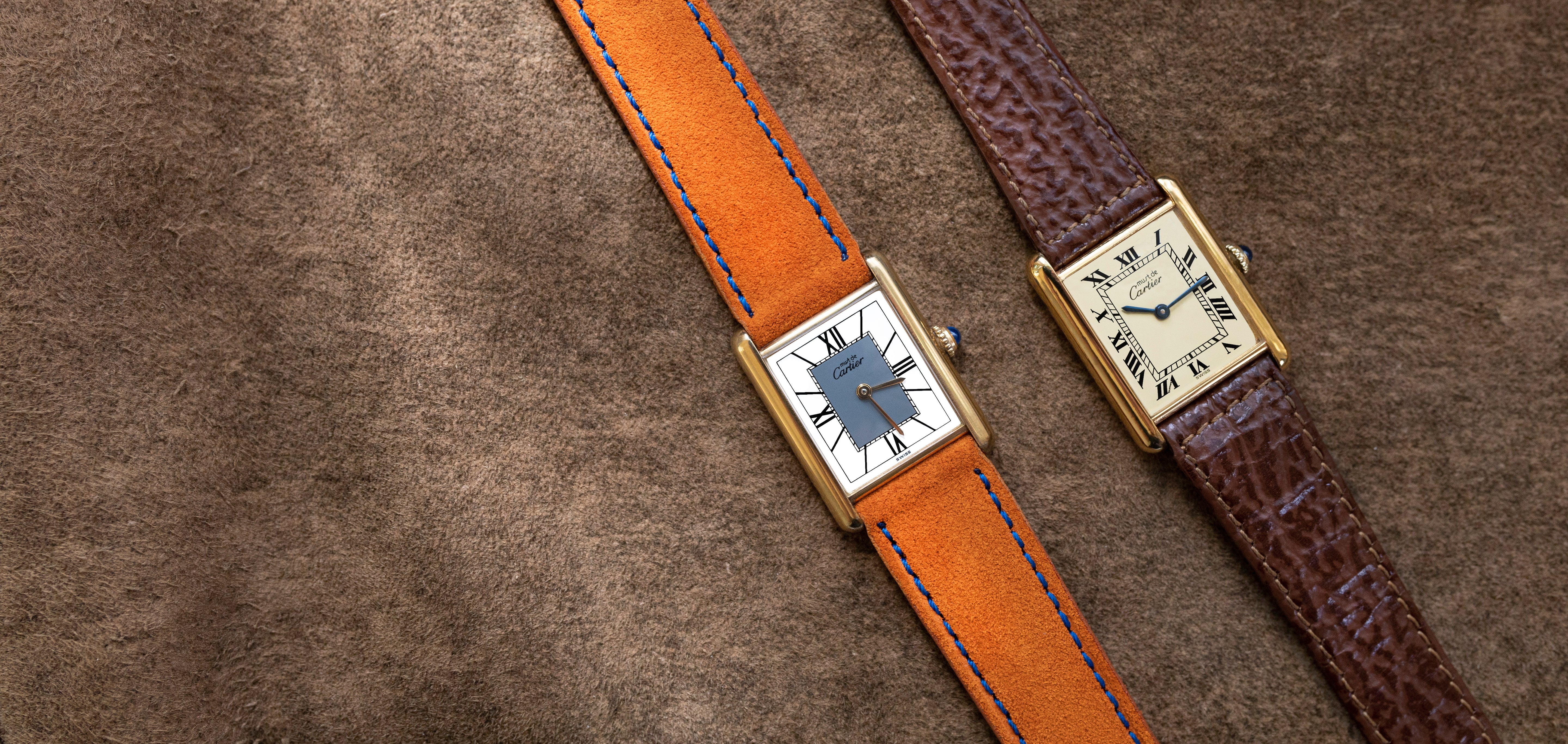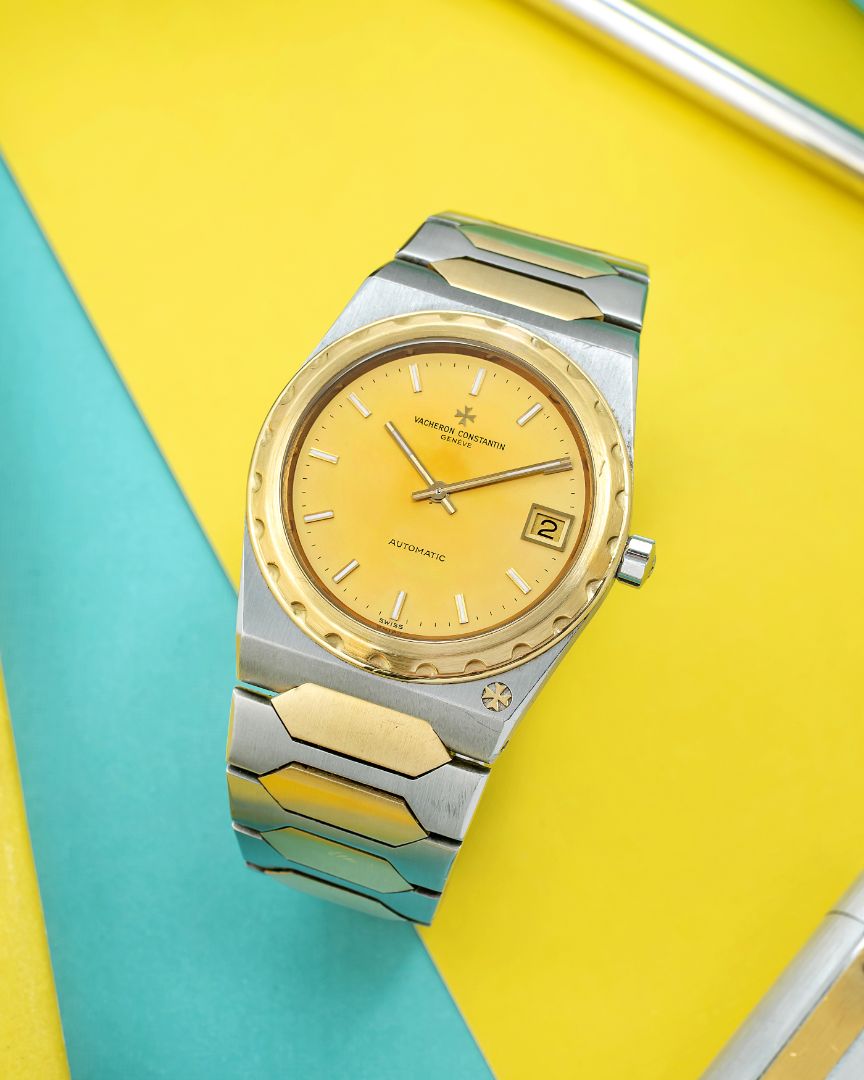
Vacheron Constantin 222
The Vacheron Constantin 222 Jumbo holds a special place in the history of luxury sports watches, emerging during a pivotal time in the 1970s when Swiss watchmaking was undergoing both crisis and reinvention. Launched in 1977 to celebrate the brand’s 222nd anniversary, the 222 was Vacheron’s entry into the growing market for high-end steel sports watches with integrated bracelets—a category pioneered by Audemars Piguet’s Royal Oak in 1972 and Patek Philippe’s Nautilus in 1976. Unlike those two, which were famously designed by Gérald Genta, the 222 was created by a young German designer named Jörg Hysek. The most sought-after version was the “Jumbo,” featuring a 37mm stainless steel case, flat tonneau-shaped profile, and a distinctive notched bezel with the Vacheron Maltese cross subtly inset at 5 o’clock. It was powered by the ultra-thin caliber 1121, derived from the Jaeger-LeCoultre 920 movement, the same base used in both the Royal Oak and Nautilus.
The 222 was produced in very limited numbers between 1977 and 1985, with fewer than 500 examples of the steel Jumbo version made, making it an exceptionally rare collector’s piece today. For many years, it remained an under-the-radar cult classic, overshadowed by its more famous peers, until renewed interest in integrated bracelet designs brought it back into the spotlight.
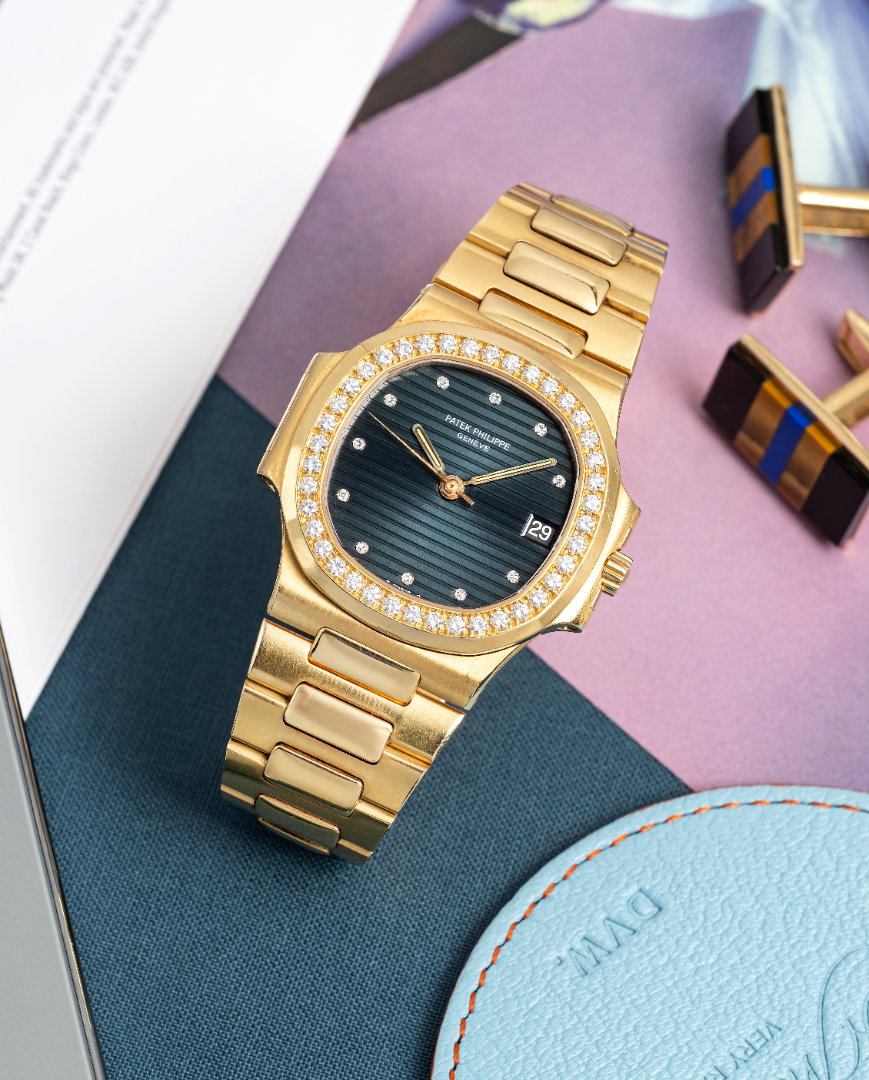
Patek Philippe Nautilus
The Patek Philippe Nautilus is one of the most iconic luxury sports watches ever created, with a history that traces back to the mid-1970s—a transformative period for Swiss watchmaking. The story of the Nautilus began in 1976, when Patek Philippe introduced the reference 3700/1A, marking the brand’s first foray into the stainless steel luxury sports watch segment. At the time, this move was considered bold, as Patek was known almost exclusively for its elegant gold dress watches.
The Nautilus was designed by the legendary Gérald Genta, the same designer behind the Audemars Piguet Royal Oak (1972). Genta famously sketched the watch while dining near a Patek executive at a Basel fair, inspired by the shape of a ship’s porthole window. The resulting design featured a rounded octagonal bezel, an integrated steel bracelet, and a large, slim case. The first model, the 3700, earned the nickname “Jumbo” due to its 42mm size—considered oversized at the time. It was powered by the ultra-thin caliber 28-255C, based on the Jaeger-LeCoultre 920 movement, which helped maintain its slim and elegant profile.
The Nautilus was marketed with the slogan “One of the world’s costliest watches is made of steel”, emphasizing its luxurious nature despite being crafted from a utilitarian material. Initially, it was a slow seller, as the concept of a high-end steel watch was still new to many collectors. However, over time, the Nautilus gained traction as both a design and technical masterpiece.
Throughout the 1980s and 1990s, the Nautilus family expanded with smaller case sizes (3800), complications like a moonphase (3712), and precious metal versions. The modern revival came in 2006, celebrating the model’s 30th anniversary with the launch of the 5711/1A, which quickly became one of the most coveted luxury watches in the world. The 5711 retained the DNA of the 3700 but added modern updates, including the in-house caliber 324 S C. Other models like the 5712 (moonphase and power reserve) and 5980 (chronograph) further cemented the Nautilus as a versatile, high-luxury sports collection.
By the 2010s, the Nautilus had transcended its initial underdog status to become one of the most sought-after watches globally, with demand far exceeding supply. Patek’s decision to discontinue the 5711/1A in 2021 only fueled its desirability, making vintage references like the 3700 and early 5711s some of the most collectible modern watches.
Today, the Nautilus stands as a symbol of both Patek Philippe’s innovative spirit and timeless design, seamlessly blending sporty elegance with horological excellence. Its combination of heritage, rarity, and iconic design has made it a grail watch for collectors worldwide.
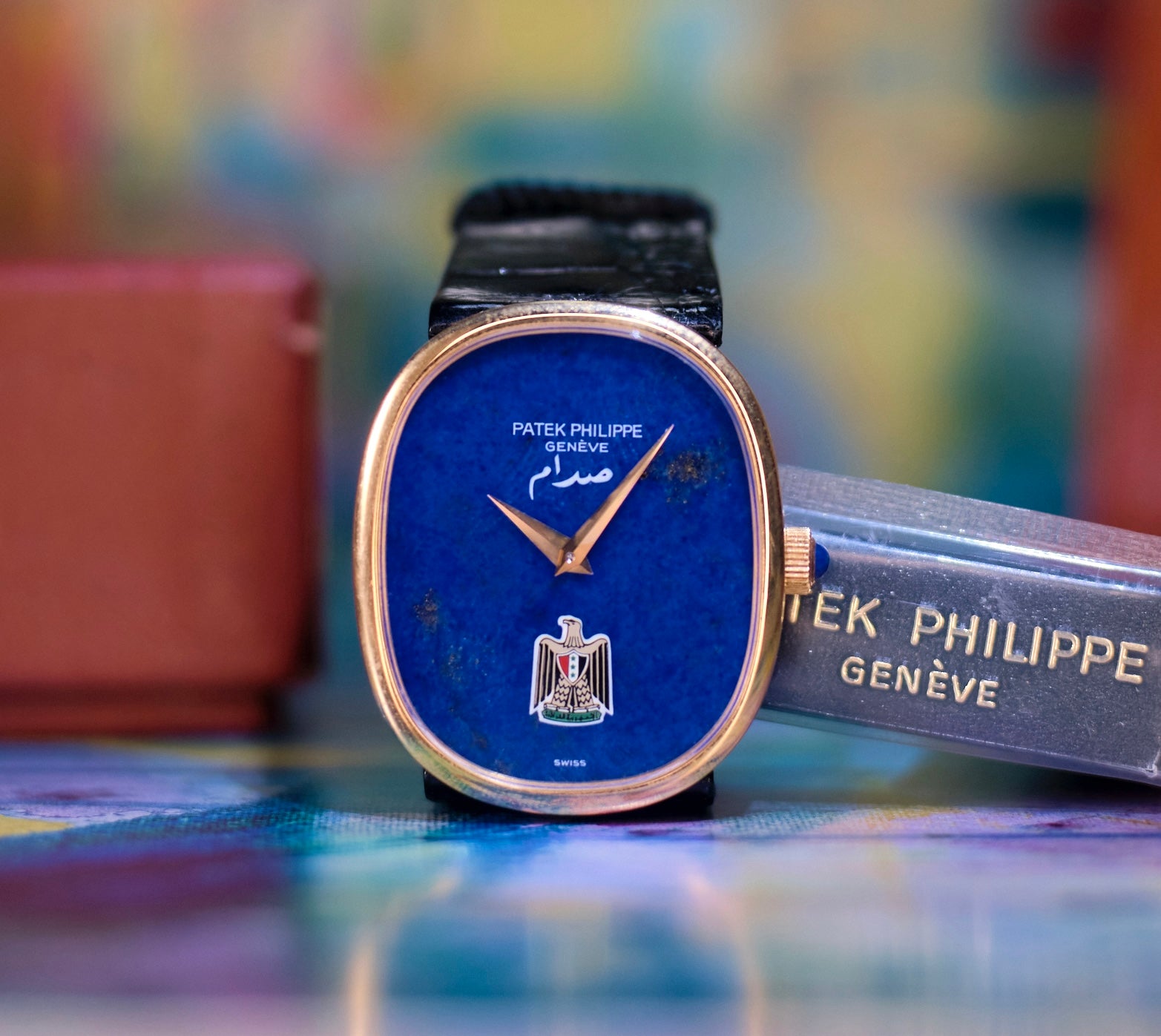
Patek Philippe Ellipse
The Patek Philippe Golden Ellipse is one of the brand’s most enduring and quietly elegant models, celebrated for its unconventional design and mathematical inspiration. Introduced in 1968, the Golden Ellipse was a bold departure from traditional round or rectangular watch shapes, embracing a unique elliptical case based on the golden ratio—a mathematical proportion (approximately 1:1.618) that has long been associated with beauty and harmony in art, architecture, and nature.
At the time of its release, Patek Philippe was looking to modernize its offerings and appeal to changing aesthetic tastes of the late 1960s. The Golden Ellipse, with its minimalist dial, slender case, and integrated bracelet options, exemplified a new kind of quiet luxury. It stood out not through complication or mechanical bravado, but through pure proportion and refinement. The earliest models, like the ref. 3548, featured ultra-thin manual-wind movements, and by the early 1970s, the line evolved to include automatic references such as the 3738, which became one of the longest-running Patek references in production. The dials were often rendered in rich sunburst blue or black with simple baton markers, highlighting the purity of the design.
Throughout the 1970s and 1980s, the Ellipse became a popular choice for collectors who appreciated subtlety, and it was frequently offered in precious metals like 18k yellow or white gold, often with matching mesh or integrated bracelets. Despite never being a headline-grabbing watch like the Nautilus or Calatrava, the Golden Ellipse developed a loyal following for its timeless aesthetic, discreet wearability, and exceptional craftsmanship.
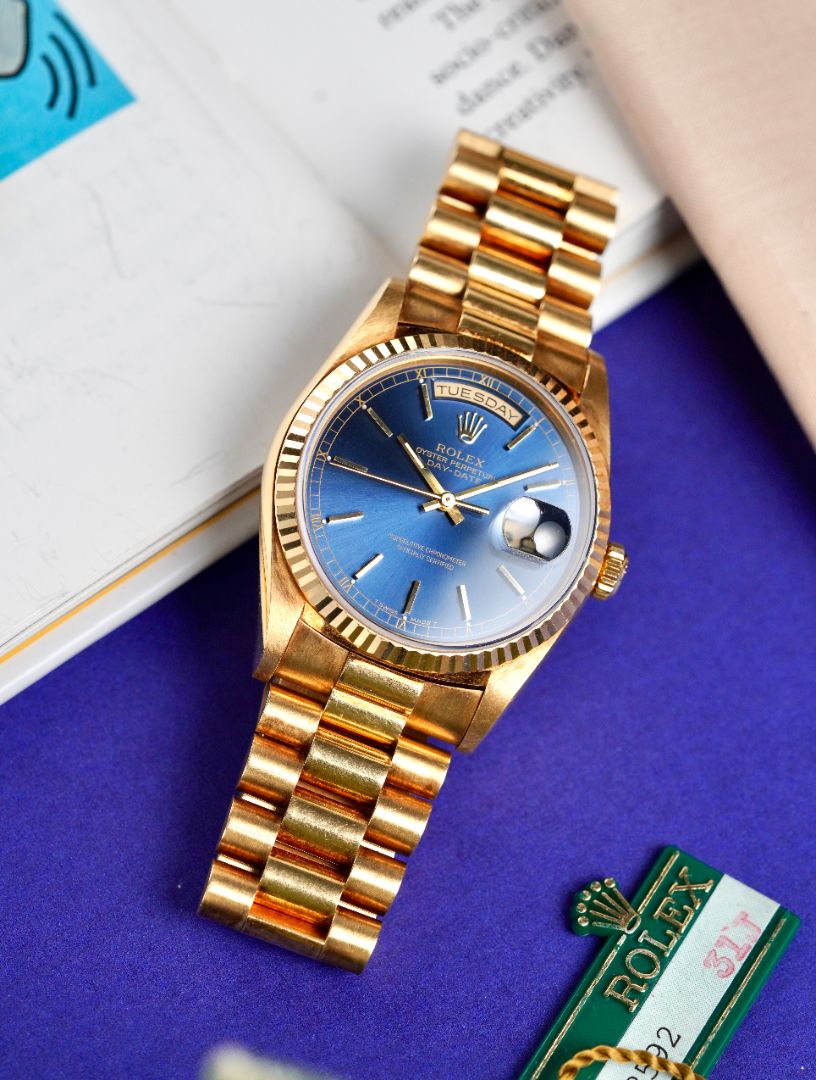
Rolex Daydate
The Rolex Day-Date, introduced in 1956, is a watch that has come to symbolize prestige, authority, and timeless excellence. As the world’s first wristwatch to display both the date and the day of the week spelled out in full, it marked a milestone in horological innovation. Immediately embraced by leaders, visionaries, and icons of influence, the Day-Date quickly earned its legendary title: the “President’s Watch.”
Distinguished by its refined aesthetics, the Day-Date is most often seen in precious metals—crafted exclusively in gold or platinum. Its fluted bezel, perfectly balanced proportions, and the instantly recognizable President bracelet combine to create a design that is both elegant and powerful. Beyond its appearance, the Day-Date embodies Rolex’s relentless pursuit of precision and durability, powered by robust in-house movements that ensure reliability across generations.
What sets the Day-Date apart is its aura of distinction. Worn by presidents, royalty, and cultural icons, it represents success and achievement like no other watch. Each Day-Date, whether set with diamonds, crafted in classic yellow gold, or executed in understated platinum, carries with it the gravitas of a timepiece that has defined luxury for nearly seven decades.
The Rolex Day-Date is not just a watch; it is a statement of accomplishment, a symbol of leadership, and an enduring icon of the Rolex legacy.
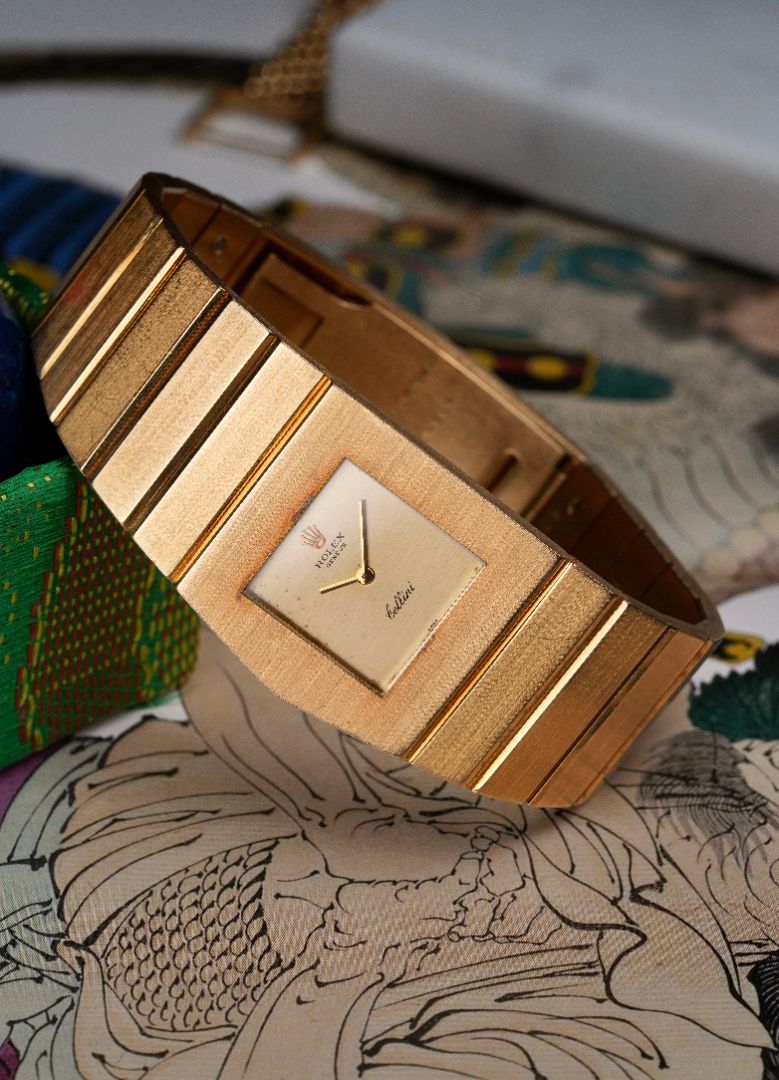
Rolex King Midas
ROLEX KING MIDAS: A TIMELESS MASTERPIECE OF DESIGN AND CRAFTSMANSHIP
The Rolex King Midas stands as one of the most avant-garde and exclusive timepieces ever produced by the brand. Introduced in 1962, this limited-production model was designed by the legendary Gérald Genta, who later became renowned for creating the Audemars Piguet Royal Oak and the Patek Philippe Nautilus. The King Midas was Rolex's bold foray into high jewelry and avant-garde design, setting it apart from the brand's more traditional offerings.
Origins and Inspiration
The King Midas was inspired by Greek mythology, specifically the tale of King Midas, who possessed the ability to turn everything he touched into gold. This mythological reference is reflected in the watch's design, which features an asymmetrical case and a left-hand winding crown, symbolizing the king's golden touch. The design was also influenced by the Greek Pantheon, with the case resembling a temple and the bracelet's grooves mimicking the columns.
PRODUCTION AND CASE VARIANTS
The King Midas was produced in three main references:
Reference 9630 (1962–1972): The original and most iconic model, featuring an asymmetrical 18k gold case with a left-hand winding crown. Approximately 800 pieces were made, with 144 in white gold and the remainder in yellow gold. The case dimensions are approximately 27.5 mm wide.
Reference 3580 (1973–1975): A successor to the 9630, this model retained the asymmetrical design but featured slight modifications, including a different bracelet and clasp design. Production numbers are estimated to be around 500 pieces.
Reference 4315 (1976–1980s): The final iteration, which saw the introduction of a thinner bracelet and a caseback secured with screws. This model marked the transition of the King Midas into the Cellini line.
The King Midas was available in two case shapes:
Asymmetrical Case: The original design, characterized by its unique, off-center case and left-hand winding crown.
Square Case: Introduced in later models, this design featured a more traditional square case shape.
COLLECTIBILITY AND RARITY
The Rolex King Midas is highly collectible due to its limited production, unique design, and association with Gérald Genta. The king midas, in particular, is considered one of the most desirable among collectors. Its rarity is further enhanced by the fact that many pieces have been lost or melted down over the years. Notable owners include Elvis Presley, who was gifted a yellow gold reference 9630 during his 1970 tour, and Francisco Scaramanga, the villain in the 1974 James Bond film The Man with the Golden Gun, portrayed by Sir Christopher Lee.
WHY IT STANDS OUT
The King Midas is not just a watch; it's a statement piece that embodies the fusion of art, mythology, and horology. Its avant-garde design, combined with Rolex's renowned craftsmanship, makes it a rare treasure for discerning collectors. Owning a King Midas is an opportunity to possess a piece of Rolex's history and a testament to the brand's willingness to push the boundaries of watchmaking.

Cartier Baignoire
The Cartier Baignoire is one of the maison’s most poetic creations—an emblem of timeless elegance, femininity, and Parisian chic. First conceived in 1912 and perfected during the 1950s, the Baignoire takes its name from the French word for “bathtub,” a playful reference to its elongated oval case. What might have seemed whimsical at first glance became a design that redefined women’s watchmaking, transforming simplicity into an enduring symbol of sophistication.
Unlike the bold angularity of Cartier’s other icons such as the Tank or Santos, the Baignoire embodies softness and subtlety. Its flowing lines and delicate curves echo the grace of jewelry design, reflecting Cartier’s unmatched ability to merge haute joaillerie with fine horology. Over the decades, the Baignoire has been reimagined in countless forms—from discreet yellow gold models to dazzling diamond-set variations—yet it has always preserved its essence of understated luxury.
Adored by style icons, artists, and collectors alike, the Cartier Baignoire transcends trends. It is more than just a timepiece; it is a statement of elegance, a celebration of femininity, and a lasting testament to Cartier’s artistry in design. With every iteration, the Baignoire proves that true sophistication lies not in complexity, but in the mastery of form and proportion.
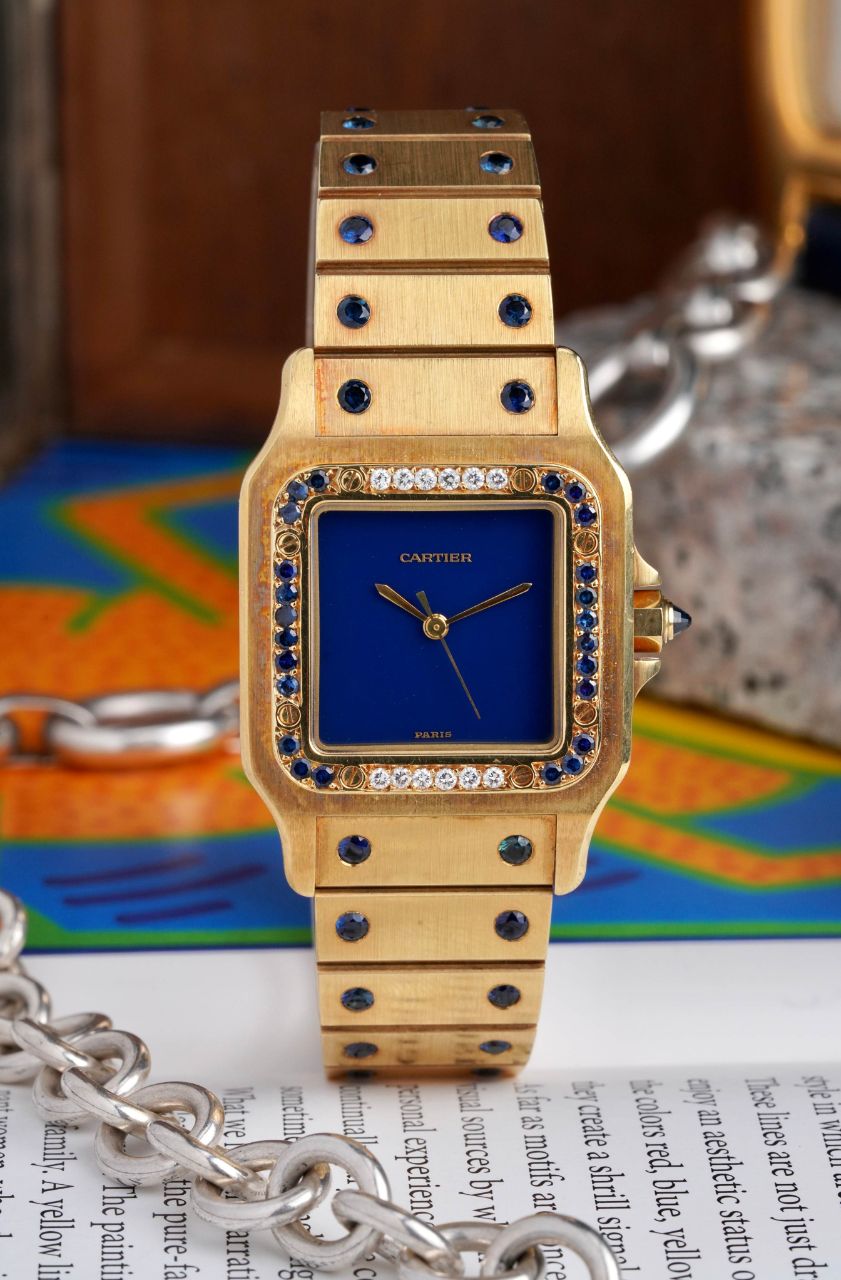
Cartier Santos
Few watches have the pedigree and enduring desirability of the Cartier Santos. Originally crafted in 1904 for pioneering aviator Alberto Santos-Dumont, the Santos broke boundaries as one of the first men’s wristwatches—and the very first designed specifically for flight. Over the decades, it has become one of Cartier’s most iconic models, evolving through limited editions, precious metals, and dial variations that have become highly sought-after by collectors worldwide.
What makes the Santos so collectible is its perfect storm of historical relevance, unmistakable design, and Cartier craftsmanship. From early Louis Cartier models to rare 1980s solid gold references with diamond factory dials, each piece tells a story of bold innovation and quiet luxury.
Whether you're drawn by its aviation roots, its Art Deco elegance, or its status as a pioneer in wristwatch history, the Cartier Santos is a must-have for any serious collector—a watch that continues to hold and build value, both emotionally and historically.

AP Royal Oak
THE CREATION OF THE ROYAL OAK
The Audemars Piguet Royal Oak was introduced in 1972, designed by Gerald Genta, a renowned Swiss designer who had already created iconic designs for several luxury watch brands. The Royal Oak was revolutionary in many ways, especially because it broke the traditional mold of what luxury watches were at the time.
Before the Royal Oak, luxury watches were typically crafted in precious metals like gold or platinum, with conservative designs. Genta’s vision for the Royal Oak was to create a bold and modern luxury watch that could withstand the test of time, both in terms of durability and style. It was the first luxury steel sports watch, made from stainless steel, a material that had previously been seen as utilitarian rather than luxurious.
One of the most distinctive features of the Royal Oak is its octagonal bezel with exposed screws, which became an iconic design element. The watch also featured an integrated bracelet, making it an all-in-one piece that was both functional and stylish. The design was so bold and revolutionary that it initially met resistance from collectors, who were skeptical about the idea of a luxury watch made of steel. However, the Royal Oak eventually became a symbol of innovation and style, transforming the entire watch industry.
WHY THE ROYAL OAK WAS SO IMPORTANT
Material Innovation: The use of stainless steel in a luxury watch was unheard of at the time. The Royal Oak was a game-changer by making steel a material that could be both durable and luxurious.
Iconic Design: Gerald Genta’s design, with its octagonal bezel and integrated bracelet, was unlike anything else on the market. Its bold, industrial design became instantly recognizable and remains a symbol of the brand today.
Market Impact: The Royal Oak helped shift the perception of what a luxury watch could be. It bridged the gap between traditional watchmaking and a new, sportier luxury aesthetic. The success of the Royal Oak is largely credited with helping Audemars Piguet become a leading luxury watch brand.
Heritage of Innovation: The Royal Oak was not just a success in terms of design, but also in terms of its technical prowess. It introduced innovations in both the case and movement construction, with a high level of finishing and craftsmanship that set new standards in the industry.
Over time, the Royal Oak evolved, and new models were introduced, including the Royal Oak Offshore in the 1990s, which offered a more rugged, larger version of the iconic design. Despite the passage of time, the Royal Oak has remained a staple of Audemars Piguet’s collection and continues to be one of the most coveted watches in the world
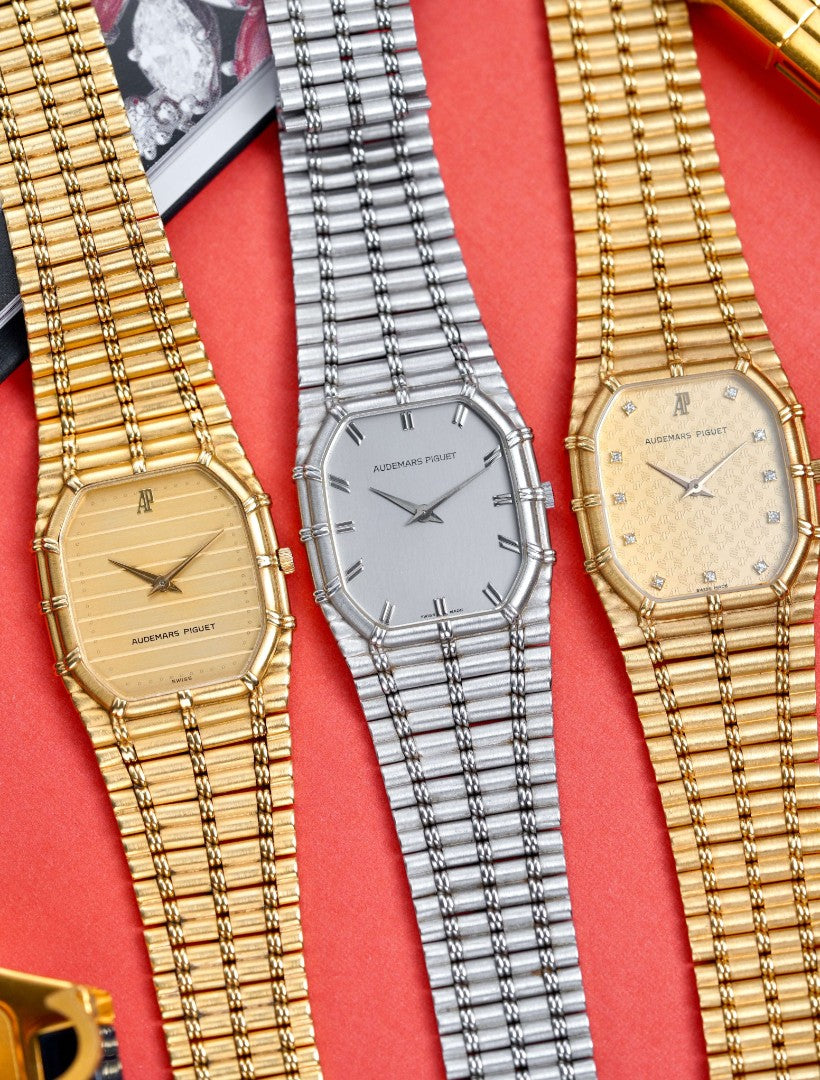
AP bamboo
The Audemars Piguet Bamboo has become one of the most sought-after vintage gold watches today—and for good reason. With its instantly recognizable bamboo-style integrated bracelet, this model blends high design with high craftsmanship, embodying a distinct moment in watchmaking when elegance, precision, and artistic flair were all equally prioritized.
The Bamboo line was introduced by Audemars Piguet in the 1970s, during a golden era of bold experimentation with case shapes and bracelet integration. These watches were designed and manufactured in very limited numbers, each painstakingly crafted by hand. The bracelet alone was a technical feat, requiring specialized artisans to construct its sculptural, jointed links that resemble bamboo stalks—fluid, flexible, and incredibly comfortable on the wrist. This wasn’t mass production—it was old-world craftsmanship at its finest.
In a world where vintage integrated designs like the Royal Oak and Nautilus dominate headlines, the AP Bamboo has carved out a loyal following of its own—celebrated for its elegance, wearability, and unique design heritage. It represents a period of creativity and bold design at Audemars Piguet that’s still unmatched, and with so few surviving in top condition, owning one is like owning a piece of refined horological sculpture.
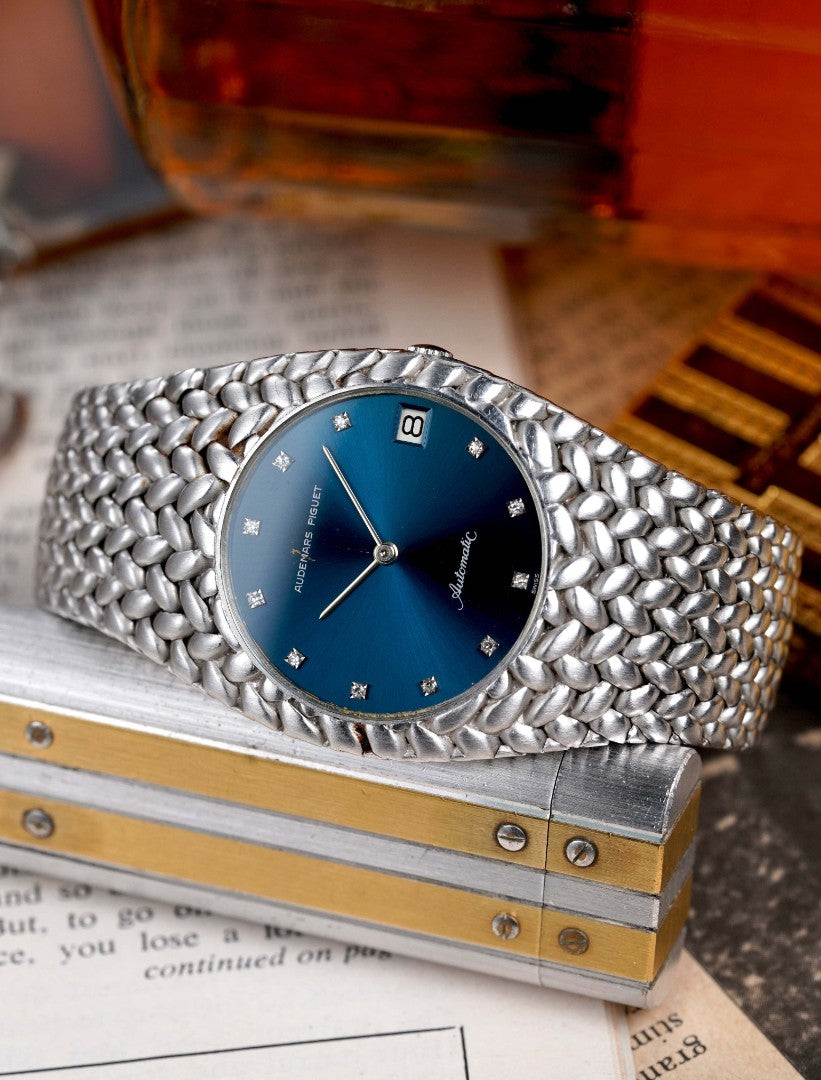
AP cobra 5403
The Audemars Piguet Cobra 5403 and the Shah of Iran: A Forgotten Royal Favorite
In the early 1970s, as the world of horology began to shift toward more radical and avant-garde designs, Audemars Piguet quietly introduced one of its boldest creations: the Cobra, reference 5403. Crafted entirely in gold with a fluid, integrated design, it was the brainchild of legendary designer Gérald Genta, who would later go on to shape the Royal Oak, Nautilus, and other icons. But before the Royal Oak took the spotlight in 1972, the Cobra had already set a standard for modern luxury — and it caught the eye of royalty.
Among the earliest and most famous wearers of the Cobra was Mohammad Reza Pahlavi, the last Shah of Iran. Known for his lavish lifestyle, Western tastes, and close ties with Swiss watchmakers, the Shah had an affinity for unique and groundbreaking timepieces. He famously wore a white gold Cobra with a dark dial, a piece that complemented his polished diplomatic image and symbolized his embrace of both modernity and monarchy. In a time when most luxury watches were round and traditional, the Cobra's serpentine, sculptural case and intricate “scale-like” bracelet stood out as something futuristic—an ideal match for the Shah’s image as a progressive ruler.
The Cobra wasn’t just a status symbol; it was a technical and artistic marvel. Its “Polonaise” bracelet, crafted by Swiss master jeweler Gilbert Albert, featured individually hand-welded and polished gold links that flowed seamlessly into the case. This design made the watch feel like a piece of high jewelry—something that likely appealed to the Shah’s impeccable eye for opulence. The watch was powered by the ultra-thin automatic Caliber 2121, developed in collaboration with Jaeger-LeCoultre, and shared with the early Royal Oak models.
Though it never reached the commercial success of its younger sibling, the Royal Oak, the Cobra has become an object of cult fascination among collectors. Fewer than 100 examples are believed to have been produced across all references, making it one of the rarest and most collectible pieces from the Audemars Piguet archives. Its value today has skyrocketed, with auction prices reaching well into six figures—particularly for early models in pristine condition, like those once worn by royalty.
After the fall of the Shah during the 1979 Iranian Revolution, many of his belongings, including his watches, became legends in the collector world. The Cobra he wore remains a symbol of a lost era—when Swiss horology and global power collided in the hands of one of the most controversial monarchs of the 20th century.
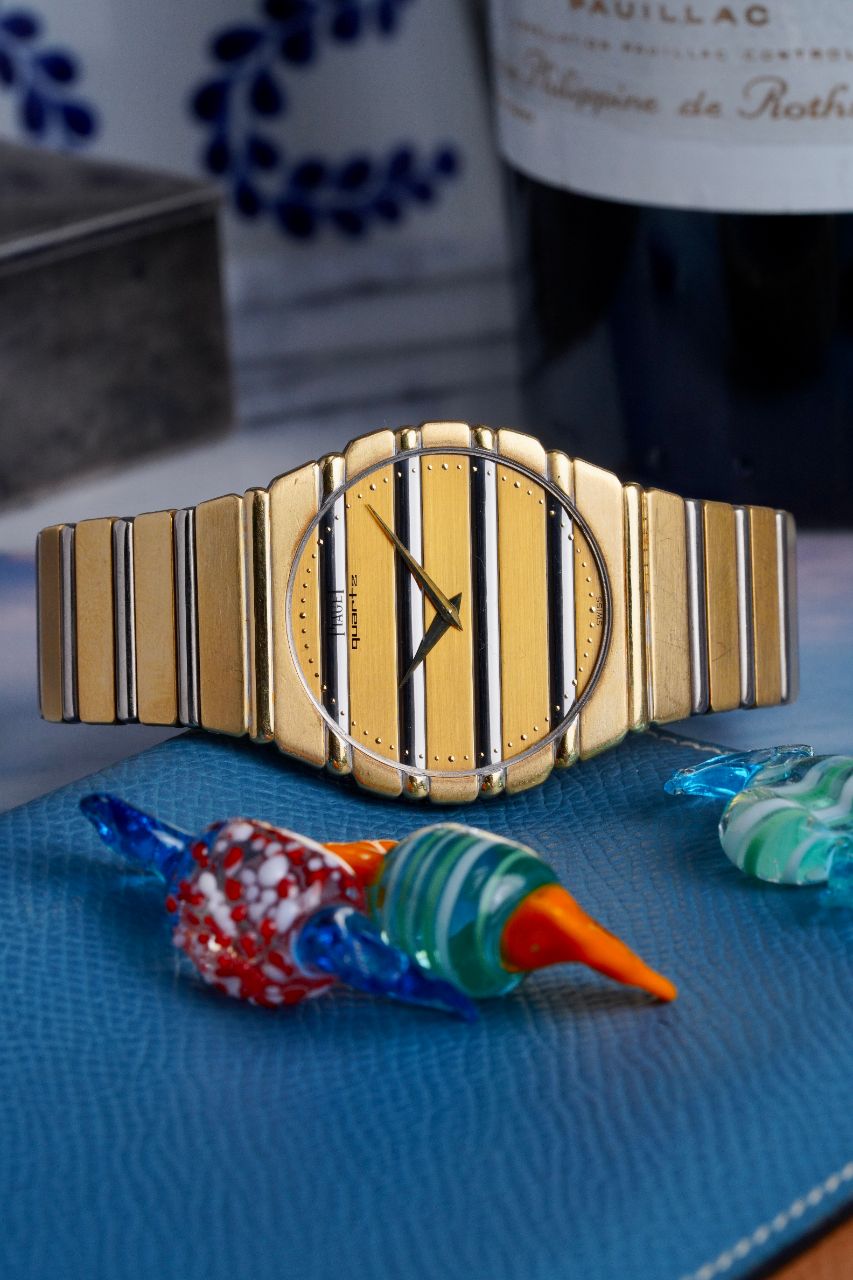
Piaget polo
The Piaget Polo was introduced in 1979 and was not just a piece of jewelry; it was a statement that changed the watch industry forever. Piaget created the 7P quartz movement, which was only 2.3mm thick, allowing the brand to maintain the signature slim, elegant design of the Polo watches. Piaget is renowned for its luxury craftsmanship, and it took months, or even years, to perfect the design of each timepiece. The Piaget Polo 1979, with its elegant, slim profile, would have required significant time spent designing the case, dial, and movement integration.
Piaget only created timepieces in precious metals, which meant there was lots of room for error, as these metals are more fragile. The brand employed the best goldsmiths in the world, who worked around the clock to ensure each Polo was made perfectly. The Polo models were carefully crafted with a fully integrated link system, featuring a brushed finish on the larger links and a polished finish on the gold gadroons. The entire watch is made of 18k gold, including the gold screws connecting each link of the bracelet, making it easy to size to any wrist.
Throughout the 1980s and beyond, the Piaget Polo gained popularity with celebrities and royalty, cementing its status as a symbol of luxury. Due to its high price tag at the time, it was a watch that only the wealthy could afford. Today, however, it is relatively more "affordable" compared to current market and gold prices.


